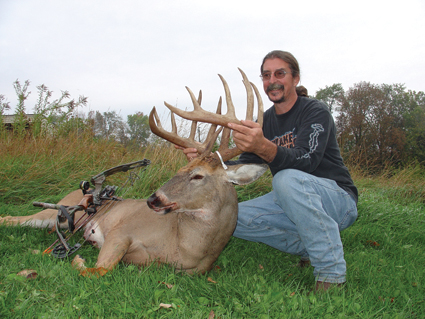Most hunters relegated to hunting public grounds have the mistaken belief that mature bucks are virtually nonexistent in these settings. In my experience, nothing could be further from the truth. Massive bucks are harvested on public land every year, but they are not easy to hunt.
The first key in killing these masters of survival lies in understanding how they elude hunters. Most base their survival on finding the locations where we don’t go. Sometimes, that consists of miles of sprawling wilderness. In most cases, it’s just something overlooked. Either way, if you want a legitimate shot at them, you must locate this no-man’s land.
These pockets of seldom-hunted land might actually be some of the easiest areas to access. A great example of this is a small, isolated growth of trees and thick brush bordering a dirt road I hunt. The area was separated from the big timber by a quarter-mile of tall grass, and the horde of other hunters would have laughed at the idea of placing a stand there. That’s exactly why I was able to kill a 3½-year-old 10-pointer in that spot. Early in life the buck realized that he could bed there, safe from the masses that hit the woods.
Water barriers and islands can create sanctuaries as well. Pitifully few hunters will slip on a pair of chest waders or pull out a canoe. Because of that, sizable chunks of land on the other side of water courses often go untouched by hunters.
Next, there are terrain features that discourage other hunters. Many people aren’t willing to scale a steep 500-foot ridge or traverse a deep gorge, particularly when ample sign tells them they can go the easy route and hunt the friendlier side they park on.
Of course, there’s always going the extra mile on the bigger tracts of land. That’s exactly what Wisconsin hunter Wally Sitka did. The first year Wally hunted one particular huge buck, he had a close encounter with the animal about a mile back in.
Before eventually arrowing the animal early in the 2007 season, Wally shifted deeper twice more, finally setting up around 2 miles from the nearest access point. His final setup was right at the doorstep of the buck’s bedding areas. Even this far from access, the buck still chose an area so thick and nasty that Sitka could only catch flashes of him before he stepped into a shooting lane.
To get to such a remote location, Wally had ridden a bike as far back as he could and walked the rest of the way. To get the buck out, he had no choice but to enlist the help of his friend J.R. Treharne. J.R. didn’t mind. After all, it’s not every day that you can help your friend drag out a public-land buck that has a perfectly clean 12-point rack and a gross score flirting with 190.
Go unnoticed
 Along with finding where other hunters don’t go, I’m sure you’ve already picked up on the second key: setting up as close to the buck’s bedroom as possible without him noticing that you’re there.
Along with finding where other hunters don’t go, I’m sure you’ve already picked up on the second key: setting up as close to the buck’s bedroom as possible without him noticing that you’re there.
That’s where some woodsmanship and common sense come into play. When trying to find that bedding area, scour the area, looking for big-buck sign. If you can follow it correctly, those big tracks, scrapes and rubs will show you the path.
Look for one of three different features: First, the thickest, nastiest stuff in the area is always a good bet. Some form of topography that provides a superior view is another good one. Finally, look for nasty terrain that the buck can use as a safety barrier. Bedding at the edge of a sharp ravine or at the base of a sheer wall blocks the possibility of danger approaching from one or more directions. Most times, a buck’s bed will offer superior cover, a view, a safety barrier or a combination of those features. Next, find that big depression that indicates a bed and you’re in business.
The buck’s access and exit routes are typically easy to pinpoint. However, common sense and an analysis of the terrain should be used to determine how far one must to go to remain unnoticed.
Keeping disturbances around the stand to a minimum is a huge concern. Go in as odor-free as possible, don’t mill around the stand and generally keep disturbances to a minimum. You must keep a buck ignorant to your stand location. Mature bucks do exist on most chunks of heavily hunted public grounds. No, their numbers aren’t as high as on large areas of heavily
managed grounds, and they are nowhere near as easy to kill. However, that doesn’t change the fact that they are there for those willing and able to take them.
To do so, the first key is finding where other hunters aren’t. Next, locate and set up as close to that bedding area as you safely can. Finally, do your very best not to draw attention to yourself. Do that, hope for a little luck, and going all out on public land just might pay off in a very big way.






